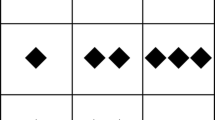Abstract
Does connectionism spell doom for folk psychology? I examine the proposal that cognitive representational states such as beliefs can play no role if connectionist models—interpreted as radical new cognitive theories—take hold and replace other cognitive theories. Though I accept that connectionist theories are radical theories that shed light on cognition, I reject the conclusion that neural networks do not represent. Indeed, I argue that neural networks may actually give us a better working notion of cognitive representational states such as beliefs, and in so doing give us a better understanding of how these states might be instantiated in neural wetware.
Similar content being viewed by others
Notes
A similar point about the ubiquitousness of distributed representations is made in van Gelder (1991).
Clark and Toribio (1994) offer an account of representational encoding at the level of hidden-unit activation. However, it is left undetermined in their formulation just what propositional content might be encoded by these units. This problem is overcome in the current proposal by including input activations as part of B.
References
Churchland PM (1981) Eliminative materialism and the propositional attitudes. J Philos 78:67–90
Clark A (1995) Connectionist minds. In: MacDonald C, McDonald G (eds) Connectionism: debates on psychological explanation. Blackwell, Oxford, pp 339–356
Clark A, Toribio J (1994) Doing without representing. Synthese 101:401–431
Dretske F (1988) Explaining Behavior. MIT Press, Cambridge
Elman J (1991) Distributed representations, simple recurrent networks and grammatical structure. Mach Learn 7:195–224
Elman J (1990) Finding structure in time. Cogn Sci 14:179–211
Forster M, Seidel E (1994) Connectionism and the fate of folk psychology: a reply to Ramsey, Stich and Garon. Philos Psychol 7:437–452
O’Brien G (1991) Is connectionism common sense? Philos Psychol 4:165–178
Papineau D (1987) Reality and representation. Blackwell, Oxford
Ramsey W (1994) Distributed representation and causal modularity: a rejoinder to Forster and Saidel. Philos Psychol 7:453–461
Ramsey W, Stich S, Garon J (1991) Connectionism, eliminativism and the future of folk psychology. In: Ramsey W et al (eds) Philosophy and connectionist theory. Lawrence Erlbaum Associates, Hillsdale, pp. 199–228
Rumelhart DE, Todd PM (1993) Learning and connectionist representations. In: Meyer DE, Kornblum S (eds) Attention and performance XI. MIT Press/Bradford Books, Cambridge, pp 3–30
Sejnowski T, Rosenberg C (1987) Parallel networks that learn to pronounce english text. Complex Syst 1:145–168
Sellars W (1956) Empiricism and the philosophy of mind. In: Feigl H, Scriven M (eds) Minnesota studies in the philosophy of science, vol 1. University of Minnesota Press, Minneapolis
Skokowski P (2004) Structural content: a naturalistic approach to implicit belief. Philos Sci 71:362–379
Smolensky P (1988) On the proper treatment of connectionism. Behav Brain Sci 11:1–74
Stich S (1991) Causal Holism and commonsense psychology: a Reply to O’Brien. Philos Psychol 4:179–181
Stich S, Warfield P (1995) Reply to Clark and Smolensky: do connectionist minds have beliefs? In: MacDonald C, McDonald G (eds) Connectionism: debates on psychological explanation. Blackwell, Oxford, pp 395–411
van Gelder T (1991) What is the “D” in “PDP”? A survey of the concept of distribution. In: Ramsey W et al (eds) Philosophy and connectionist theory. Lawrence Erlbaum Associates, Hillsdale, pp 33–60
Acknowledgments
I would like to thank Jay McClelland, Jeff Yoshimi, and Jesús Navarro for helpful comments and advice. I would also like to thank David Rumelhart for originally introducing me to the issues examined here.
Author information
Authors and Affiliations
Corresponding author
Rights and permissions
About this article
Cite this article
Skokowski, P. Networks with attitudes. AI & Soc 23, 461–470 (2009). https://doi.org/10.1007/s00146-007-0175-5
Received:
Accepted:
Published:
Issue Date:
DOI: https://doi.org/10.1007/s00146-007-0175-5




